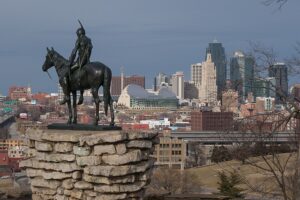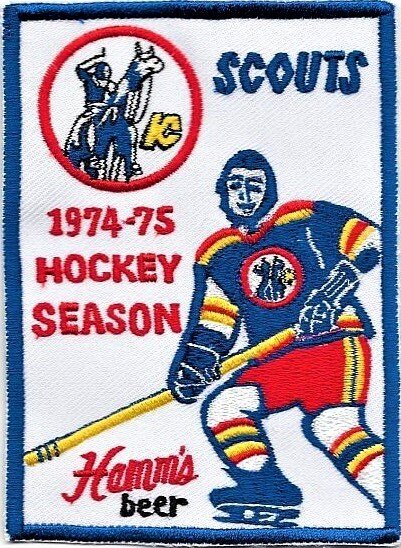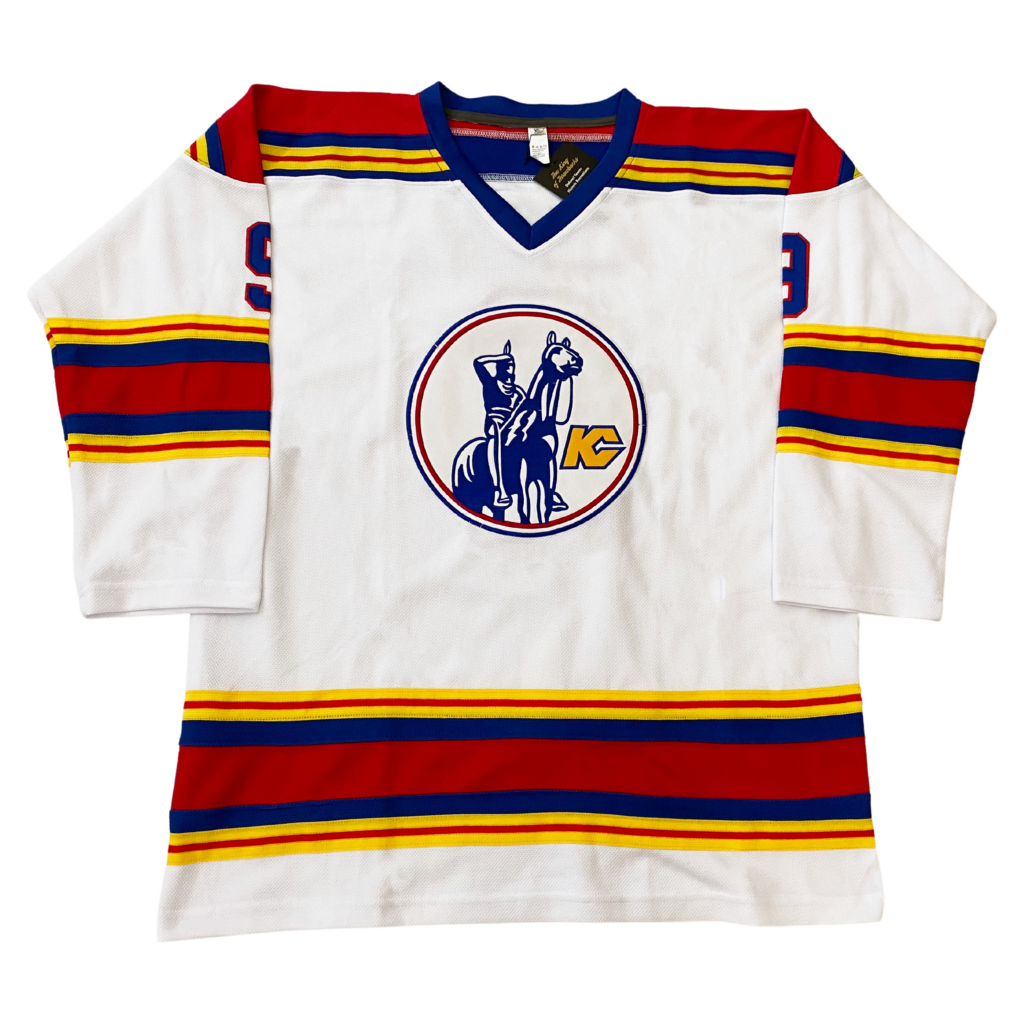National Hockey League (1974-1976)
Tombstone
Born: June 8, 1972 1Washington, Kansas City Get Teams, AP via The Portsmouth Times, Jun. 9, 1972
Died: July 26, 1976 (moved to Denver and became Colorado Rockies)2Scouts Moving to Denver, AP via The St. Joseph News-Press, Jul. 27, 1976
First Game: October 9, 1974 (L-6-2 @ Toronto Maple Leafs)
Last Game: April 4, 1976 (L 5-2 @Vancouver Canucks)
Stanley Cup Championships: None
Arena
Kemper Arena
Opened: September 30, 1974
Marketing
Team Colors:
Blue, Red, Yellow, White
Ownership
Owners:
Kansas City Hockey Associates
Retro north Stars
Kansas City Scouts Jerseys, T-shirts, and hoodies
When it comes to replica jerseys, look no further than Royal Retros, who put extraordinary detail into their fully customizable hockey sweaters.
Free Customization Included
Each jersey individually handmade
Any name and number
Heavyweight sewn tackle twill
100% polyester
Heavyweight fabric made to game standards
Fight strap included
Multiple colors and styles available. It’s not just jerseys, though. Royal Retros has Scouts T-shirts, and hoodies. Order today, SAVE 10%, and rep old-time Kansas City hockey.
Background
In the professional sports franchise arms race of the 1970s, there were many casualties, particularly in the world of hockey. In 1974, the National Hockey League (NHL) was finishing the second year of an entrenched battle with the rival World Hockey Association (WHA), which debuted in 1972. When the 1973-74 season ended, there were 28 professional teams in North America, up from just six in 1966-67.
The WHA had 12 teams, while the NHL boasted 16. The competition for players and fans (some cities had teams in both leagues) was costly to both sides. To keep its rival at bay, the NHL decided to add two more teams in 1974 to begin play in 1976. The league awarded franchises to Kansas City and Washington, D.C.
They would be the last two additions to the league until they vanquished the WHA in 1979 and absorbed four of the rival league’s six surviving teams.
Getting Started
Things looked promising for the new pro hockey team in Kansas City, the town’s first after a number of minor league clubs had called KC home. A new venue was scheduled to open in time for the team’s first season in 1974, the then state-of-the-art Kemper Arena, which they would share with the NBA’s Kansas City-Omaha Kings.
Meanwhile, the team searched for a nickname. At first, they chose Mohawks, which was relevant for two reasons. It was the name of a former minor league team that had played in the city for 25 years starting in 1926. That club had various nicknames but finished their run as the Mohawks. Also, with Kansas City straddling two states, the name seemed appropriate as it combined Missouri’s postal abbreviation, MO, with the nickname of Kansas residents, Jayhawks. The Chicago Black Hawks, however, objected, citing the obvious similarity to their nickname.
A name-the-team contest produced “Scouts,” inspired by a local statue that overlooks downtown from its location in Penn Valley Park. The statue, dedicated in 1922, honors the area’s Native American tribes.

Hitting the Ice
After two years of planning and preparation, the Scouts hit the ice for the first time on October 9, 1974, in a game against the Toronto Maple Leafs in Maple Leaf Gardens. The contest was part of an eight-game road trip scheduled, in part, due to construction delays at Kemper Arena.
The Scouts lost 6-2 to the Leafs and dropped the next four games before managing a 4-4 tie against the California Golden Seals, followed by two more losses. While their roommates, the Kings, were able to host the Washington Bullets on October 22, the Scouts stayed on the road for nearly a month.
On November 2, 1974, the Scouts finally played their home opener in Kemper Arena against the Chicago Black Hawks in front of 14,758 fans. The home side fell 4-3. The team finally notched its first win the next night in Washington, D.C., beating the Capitals, the league’s other expansion team, 5-4.
The Scouts finished their first season with a record of 15-54-11, good for last in the Smythe Division. Only the Capitals fared worse, finishing 8-67-5.
Hope Fades
After a promising start to the 1975-76 season, in which the Scouts came to within striking distance of a playoff spot, the ice gave way. A second-half slump erased any hope of a post-season appearance, and the Scouts finished with an even worse record than the one they had posted in their first season, 12-56-12. They did manage one more win than the Capitals, but the future for the Scouts was much bleaker than that of the team in D.C.
Indeed, the Capitals owner Abe Pollin had deep pockets and could withstand the financial onslaught often associated with owning an expansion team. However, the Scouts’ 37-person syndicate, combined, couldn’t absorb the Scouts’ losses, nor could they afford to have patience while the team evolved. Average attendance did improve slightly in the team’s second year, from 7,356 to 7,892, but that was far below the 13,200 fans per game the league was averaging. The Scouts were next to last in attendance for both seasons, with only the California Golden Seals drawing fewer fans.
Things Are Tough All Over
Speaking of the Golden Seals, the league had many fires it was trying to put out as the 1974-75 season came to a close, with several teams, including the Scouts and Seals, in financial trouble.
By the time Scouts and Caps debuted two years earlier, the NHL had canceled plans to expand to Seattle, Denver, and Cincinnati. The latter two cities wound up in the WHA. Seattle tried to woo the cash-strapped Pittsburgh Penguins to the Pacific Northwest, but a last-minute deal kept the team in Western Pennsylvania.
At the start of the 1974-75 season, there were 32 pro hockey teams in North America, 18 in the NHL, and 14 in the World Hockey Association (WHA). Two of the teams in the latter wouldn’t make it to the end of the season. Competition for players continued to deplete the overall talent pool and drove up salaries.
Despite the reluctance of the NHL to relocate teams, there seemed to be no other solution to the woes of the Seals and Scouts. Cleveland and Denver emerged as the top two candidates to get the struggling teams. The Seals wound up becoming the Cleveland Barons.
A last-ditch effort to sell the Scouts to Kansas City interests fell apart when the league informed the prospective new owners they would still be on the hook for the balance of the team’s expansion fee, as well as territorial rights payments to the cross-state St. Louis Blues. On July 26, 1976, the Scouts were sold to Denver-based oilman Jack A. Vickers. They were renamed the Colorado Rockies.
Legacy
In Colorado, the team was, to rework the Gordon Gekko quote from Wall Street, a dog with pretty much the same set of fleas. Poor play on the ice, along with instability in the front office and behind the bench, led the team to once again pack up the moving vans. After six seasons in Denver, the team moved to New Jersey on May 27, 1982, and are today known as the New Jersey Devils.
Before the Scouts franchise was awarded, the city was home to the Kansas City Blues of the Central Hockey League. They were a farm team of the St. Louis Blues. After the Scouts moved to Denver in 1976, the franchise was restarted. In 1977, they became the Kansas City Red Wings as their parent club became Detroit’s NHL team. They folded in 1979.
In 1990, the city welcomed a team in the International Hockey League (IHL) when the dormant Toledo Goaldiggers franchise was revived as the Kansas City Blades. Today, the Kansas City Mavericks of the ECHL represent the area, playing their games in suburban Independence, MO.
Our friends at the Good Seats Still Available podcast did an episode on the KC Scouts:
Kansas City Scouts Video
Chicago Black Hawks at Kansas City Scouts, November 2, 1974.
##


